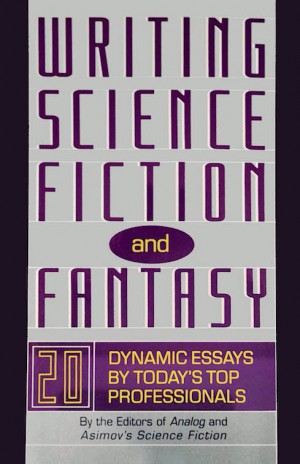Book Tour: Writing Science Fiction & Fantasy, Ch. 2
Sometimes I run across an older book that’s usually out-of-print, but has exceptional wisdom locked up in its pages. I found this one at my local Half Priced Books.

The very nature of this book—20 essays about writing by the best SFF authors—makes it hard to review as a whole. I think a better strategy is to look at each chapter in detail.
See all of my WSF&F chapter reviews.
Chapter 2: Living the Future: You Are What You Eat
Chapter two is much longer than Heinlein’s chapter one, but covers more ground. It’s written by Gardener Dozois, and names the mistakes that plague writers new to science fiction. He starts out with a discussion of 1950s syndrome.
This is one of the cardinal sins that will get a writer rejected from publications with even the lowest standards. What is 1950s syndrome? It’s when a generic American suburban setting from the black & white TV era is dressed up with “future tech.”
This type of story is not only boring1 it is downright offensive in today’s market. Having generic white men play with their future toys is not much of a story. If there is any character growth in the story it’s not interesting. I’ve read a lot of these stories, and once I looked past the gee-whiz technology there wasn’t a lot going on. None of the 1950 men (living up to the authors sense of manliness) grew or changed.
Another failing of genre-unsavvy authors is the idea they can take any story and set it “in the future” or “in space” and have a science fiction story. As we learned in chapter one, that just doesn’t work. There has to be some future “thing2” that creates a problem for people.
Romeo and Juliet set on a generation ship is still the same story. This is also why it’s one of the reasons it remains a classic. The doomed lovers story is evergreen. But it’s still not science fiction. There’s no new technology creating a condition that’s causing their problem.
Dozois make a great point of why Jules Verne’s stories have fallen3 out of favor. He predicted most of the conveniences we take for granted today. But he didn’t do the same for society. His future world was still in the Victorian era socially. It’s not a long stretch to imagine that Nemo and the Nautilus would have shook that era to its core. For the social structure to stay same is unimaginative world-building.
This goes hand-in-hand with Heinlein’s idea that the science must create the change. Nemo is a great action hero, but time has shown his is story to not be science fiction4.
Another warning is about wrapping up the story too neatly. The world we live in is wild and untamed. No matter what gloss the news tries to put on it. He points out the social upheaval of the 1960s. The Ferguson protests going on now are another wildcard. Don’t write science fiction without a some aspect that’s unresolved.5
But Dozois is not all gloom and doom. For someone that insists upon writing science fiction he has the following suggestions.
Start with reading science fiction. Do this to find out what is the state-of-the art and what is being bought. Also read the sciences. You’ll need a good working knowledge of the world around you. This is how you make your future world plausible. You have to know what’s happening today.
He ends with a suggestion on how to start: “Think yourself into the future.” But then goes on to demolish stereotypes.
Do you see slender but sky-scraping Faerie towers, elevated roadways winding from one landing platform to another? The hell you do! That’s a 1940 version of 1970, remembered by a thousand paperback covers—as a vision of 2100, it’s as inappropriate as a windmill in Times Square.6
After that attitude adjustment he rattles off a list of questions that the writer might consider: everything from living arrangement to body modifications. He ends with this bit of inspiration: “We shall fail, inevitably, but perhaps in time we shall learn how to fail somewhat less totally.”
In his chapter, Dozois shatters the myths about writing science fiction. Firstly, drop your preconceptions. Then you can be free to imagine your future world.
- As Heinlein pointed out in chapter one, stories like this are about the tech not the peope. ↩
- Either science or technology. ↩
- This book was published in 1991, and most of the observations still hold true. ↩
- This just goes to show that popular fiction can turn into literature given enough time. ↩
- The backdrop of some social change could also be the source of a new story. ↩
- Now a story that did put a windmill in Times Square would have some explaining to do. But as authors that’s our job. ↩
